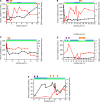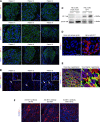B7-1 Blockade Does Not Improve Post-Transplant Nephrotic Syndrome Caused by Recurrent FSGS
- PMID: 26701979
- PMCID: PMC4978058
- DOI: 10.1681/ASN.2015091002
B7-1 Blockade Does Not Improve Post-Transplant Nephrotic Syndrome Caused by Recurrent FSGS
Abstract
FSGS is a common glomerular disorder that has a high propensity for recurrence after kidney transplant. The pathophysiology of FSGS is unknown, but podocytes seem to be the target of one or several circulating factors that lead to cytoskeleton reorganization and proteinuria. Research on podocytes has identified B7-1 as an important factor in podocyte biology and a new therapeutic target in renal disease. Indeed, in four patients with recurrent FSGS after transplant, treatment with the B7-1 blocker abatacept was associated with proteinuria remission. Here, we prospectively treated nine patients with recurrent FSGS after transplant using either abatacept or belatacept, a B7-1 blocker with higher affinity, and did not induce proteinuria remission. Furthermore, we did not detect B7-1 expression by immunofluorescence in podocytes of biopsy specimens from these or other kidney grafts or podocytes of native kidney biopsy specimens. In conclusion, B7-1 blockade did not induce FSGS remission after transplant in our study.
Keywords: focal segmental glomerulosclerosis; podocyte; signaling; transplantation.
Copyright © 2016 by the American Society of Nephrology.
Figures




Similar articles
-
Benefit of B7-1 staining and abatacept for treatment-resistant post-transplant focal segmental glomerulosclerosis in a predominantly pediatric cohort: time for a reappraisal.Pediatr Nephrol. 2023 Jan;38(1):145-159. doi: 10.1007/s00467-022-05549-7. Epub 2022 May 4. Pediatr Nephrol. 2023. PMID: 35507150 Free PMC article.
-
Successful Treatment With Abatacept in Recurrent Focal Segmental Glomerulosclerosis After Kidney Transplant.Exp Clin Transplant. 2019 Jan;17(Suppl 1):178-180. doi: 10.6002/ect.MESOT2018.P53. Exp Clin Transplant. 2019. PMID: 30777550
-
Recurrent Focal Segmental Glomerulosclerosis and Abatacept: Case Report.Exp Clin Transplant. 2016 Aug;14(4):456-9. doi: 10.6002/ect.2014.0154. Epub 2014 Nov 27. Exp Clin Transplant. 2016. PMID: 25432003
-
Focal segmental glomerulosclerosis and renal transplantation.Transplant Proc. 2007 Apr;39(3):737-43. doi: 10.1016/j.transproceed.2007.02.010. Transplant Proc. 2007. PMID: 17445586 Review.
-
The role of B7-1 in proteinuria of glomerular origin.Nat Rev Nephrol. 2018 Sep;14(9):589-596. doi: 10.1038/s41581-018-0037-z. Nat Rev Nephrol. 2018. PMID: 29959373 Review.
Cited by
-
Management and long-term outcome of recurrent idiopathic FSGS in pediatric kidney transplant recipients.Sci Rep. 2024 Oct 26;14(1):25493. doi: 10.1038/s41598-024-74184-z. Sci Rep. 2024. PMID: 39461970 Free PMC article.
-
Patients with primary focal segmental glomerulosclerosis with detectable urinary CD80 are more similar to patients with minimal change disease in clinicopathological features.Ren Fail. 2023;45(2):2279642. doi: 10.1080/0886022X.2023.2279642. Epub 2023 Nov 9. Ren Fail. 2023. PMID: 37942512 Free PMC article.
-
Benefit of B7-1 staining and abatacept for treatment-resistant post-transplant focal segmental glomerulosclerosis in a predominantly pediatric cohort: time for a reappraisal.Pediatr Nephrol. 2023 Jan;38(1):145-159. doi: 10.1007/s00467-022-05549-7. Epub 2022 May 4. Pediatr Nephrol. 2023. PMID: 35507150 Free PMC article.
-
What is circulating factor disease and how is it currently explained?Pediatr Nephrol. 2023 Nov;38(11):3513-3518. doi: 10.1007/s00467-023-05928-8. Epub 2023 Mar 23. Pediatr Nephrol. 2023. PMID: 36952039 Free PMC article. Review.
-
Recent Treatment Advances and New Trials in Adult Nephrotic Syndrome.Biomed Res Int. 2017;2017:7689254. doi: 10.1155/2017/7689254. Epub 2017 May 3. Biomed Res Int. 2017. PMID: 28553650 Free PMC article. Review.
References
-
- Habib R, Lévy M, Gubler MC: Clinicopathologic correlations in the nephrotic syndrome. Paediatrician 8: 325–348, 1979 - PubMed
-
- Cameron JS: The enigma of focal segmental glomerulosclerosis. Kidney Int Suppl 57: S119–S131, 1996 - PubMed
-
- Canaud G, Dion D, Zuber J, Gubler MC, Sberro R, Thervet E, Snanoudj R, Charbit M, Salomon R, Martinez F, Legendre C, Noel LH, Niaudet P: Recurrence of nephrotic syndrome after transplantation in a mixed population of children and adults: Course of glomerular lesions and value of the Columbia classification of histological variants of focal and segmental glomerulosclerosis (FSGS). Nephrol Dial Transplant 25: 1321–1328, 2010 - PubMed
-
- Canaud G, Zuber J, Sberro R, Royale V, Anglicheau D, Snanoudj R, Gaha K, Thervet E, Lefrère F, Cavazzana-Calvo M, Noël LH, Méjean A, Legendre C, Martinez F: Intensive and prolonged treatment of focal and segmental glomerulosclerosis recurrence in adult kidney transplant recipients: A pilot study. Am J Transplant 9: 1081–1086, 2009 - PubMed
Publication types
MeSH terms
Substances
LinkOut - more resources
Full Text Sources
Other Literature Sources
Medical

